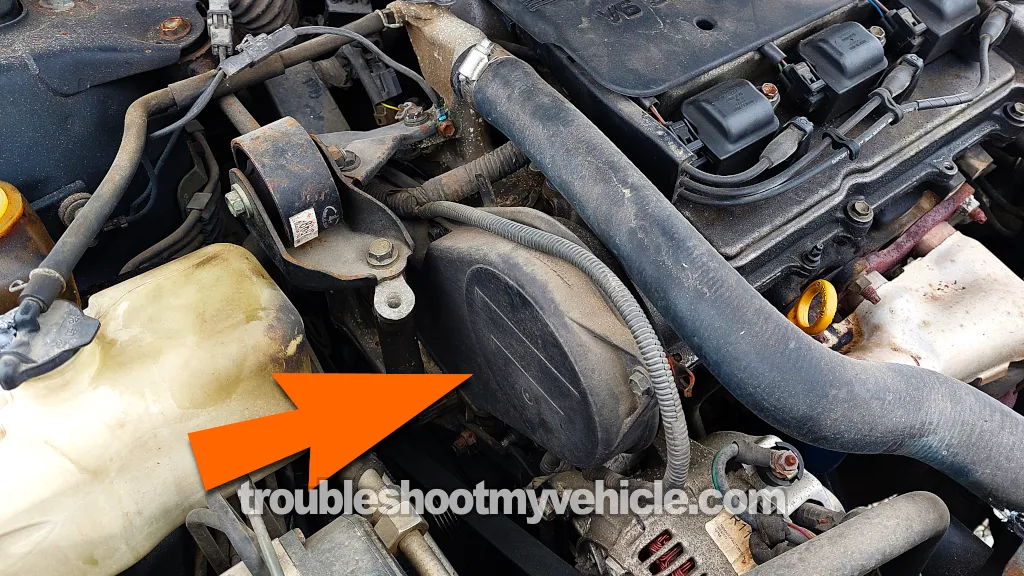
The 3.0L V6 engine in the 1992-2001 Toyota Camry is equipped with a timing belt. If it breaks, the engine is gonna crank but not start.
In this tutorial, I'm gonna explain the most common tests you can perform on this particular engine and see if a broken timing belt is causing the engine no-start issue.
Contents of this tutorial:
- What Does The Timing Belt Do?
- Symptoms Of A Broken Timing Belt.
- TEST 1: Checking Distributor Rotor Rotation (1992–1993 Models).
- TEST 2: Inspecting The Timing Belt Via Upper Timing Cover.
- TEST 3: Observing Camshaft Rotation (Bank 2).
- TEST 4: Check For Zero Engine Compression.
- TEST 5: Inspect For Timing Belt Service History.
- More 3.0L V6 Toyota Camry Tutorials.
APPLIES TO: This tutorial applies to the following vehicles:
- 3.0L V6 Toyota Camry: 1992, 1993, 1994, 1995, 1996, 1997, 1998, 1999, 2000, 2001.
Engine No-Start Diagnostics:
- How To Troubleshoot An Engine No-Start Problem (1992-1993 3.0L V6 Toyota Camry).
- How To Troubleshoot An Engine No-Start Problem (1994-2001 3.0L V6 Toyota Camry).
What Does The Timing Belt Do?
The timing belt synchronizes the rotation of the crankshaft and camshaft(s). These two components must work in perfect harmony for the engine to function (start and stay running):
- Crankshaft: Converts the up-and-down motion of the pistons into rotational motion.
- Camshaft(s): Controls the opening and closing of the engine's intake and exhaust valves, which allow air/fuel mixture into the cylinders and exhaust gases out.
The timing belt ensures the valves open/close at exactly the right moment relative to the pistons' movement. This coordination is critical for the four-stroke cycle (intake, compression, combustion, exhaust).
Symptoms Of A Broken Timing Belt
The most common symptoms of a broken timing belt on the 1992–2001 Toyota Camry 3.0L V6 (1MZ-FE engine) are:
- Engine cranks normally but fails to start
- The engine will turn over when the starter is engaged, but it will not fire or run.
- This occurs because the timing belt connects the crankshaft to the camshaft(s). If broken, the camshaft(s) stop rotating, halting valve operation and spark timing (in distributor-equipped models).
- Without valve movement, air/fuel mixture can’t enter the cylinders, and exhaust gases can’t exit.
- Faster cranking speed
- The engine cranks way faster than usual due to zero compression in all cylinders.
- Without the timing belt, the valves remain stationary, so no air/fuel mixture is compressed during cranking. Since the cylinders don't have to compress anything, cranking speed increases a whole lot.
- Zero compression across all cylinders
- A compression test will reveal 0 PSI in all cylinders because the valves are not opening/closing.
- This is a definitive symptom of a broken timing belt (or severe timing misalignment).
- No valve movement
- Removing the upper timing cover or front valve cover (Bank 2) and cranking the engine will reveal no camshaft rotation.
- A borescope inserted through a spark plug hole can also confirm valves are not moving.
- Loss of spark (1992–1993 Models)
- In distributor-equipped models (1992–1993), a broken belt stops the distributor rotor from spinning, resulting in no spark to the plugs.
- Later models (1994–2001) use coil-on-plug ignition, but the ECU may disable spark if camshaft position sensors detect no rotation.
NOTE: The 3.0L V6 (1MZ-FE) in your 1992–2001 Toyota Camry is a non-interference engine, meaning a broken timing belt won't cause internal damage. However, the engine will stop running, so it's still crucial to replace the belt at the recommended intervals to avoid being stranded!
TEST 1: Checking Distributor Rotor Rotation (1992–1993 Models)
The 1992–1993 3.0L V6 Camry uses a distributor-based ignition system. If the timing belt breaks, the camshafts (and thus the distributor rotor) will not rotate when the engine is cranked.
NOTE: This method only applies to 1992–1993 models, as later models (1994+) eliminated the distributor in favor of coil-on-plug ignition systems.
- Procedure:
- Disconnect the ignition coil from its 2-wire connector. This is a safety precaution.
- Remove the distributor cap.
- Crank the engine.
- Observe the rotor while cranking the engine.
- If the rotor does not move, the timing belt is likely broken.
TEST 2: Inspecting The Timing Belt Via Upper Timing Cover
For all 1992–2001 models, removing the upper timing cover allows direct visual inspection of the timing belt and camshaft gears.
The advantage of this method is that it provides a definitive answer and works across all model years.
NOTE: You may need a repair manual to explain the step-by-step of removing the upper timing cover.
- Procedure:
- Remove the upper timing cover.
- Check for visible damage or fraying of the belt. A broken belt will be obvious.
TEST 3: Observing Camshaft Rotation (Bank 2)
The 1MZ-FE engine's Bank 2 (cylinders 2, 4, 6) camshafts are driven by the timing belt. If the belt breaks, the camshafts will not turn during cranking.
This means we can confirm that the t-belt is broken by checking the rotation or lack of rotation of these two camshafts with the valve cover removed.
NOTE: This method requires partial disassembly but avoids full timing cover removal.
- Procedure:
- Remove the front valve cover (Bank 2).
- Crank the engine and observe the camshafts.
- If they do not rotate, the timing belt is broken.
TEST 4: Check For Zero Engine Compression
A broken timing belt disrupts valve timing, leading to zero compression in all cylinders. This causes the engine to crank faster than normal (but failing to start).
This means we can use a compression tester to check the compression of all six cylinders.
NOTE: The following tutorial explains the compression test in detail and also explains how to interpret your compression test results: How To Test Engine Compression (1992-2006 3.0L V6 Toyota Camry).
- Procedure:
- Remove all six spark plugs.
- Check the compression of each cylinder.
- If all cylinders show 0 PSI, the timing belt is likely broken.
TEST 5: Inspect For Timing Belt Service History
The 1MZ-FE engine's timing belt requires replacement every 60,000–90,000 miles (non-interference design). If the belt is overdue, a breakage is more likely.
More 3.0L V6 Toyota Camry Tutorials
You can find a complete list of 3.0L V6 Toyota Camry tutorials and wiring diagrams in this index:
Here's a sample of the tutorials you'll find there:
- How To Test The MAF Sensor (1994-1996 3.0L V6 Toyota Camry).
- How To Test The TPS (1992-1996 3.0L V6 Toyota Camry).
- How To Test The TPS (1997-2001 3.0L V6 Toyota Camry).
- How To Test The Cooling Fan Motors (1995-2001 3.0L V6 Toyota Camry).

If this info saved the day, buy me a beer!

